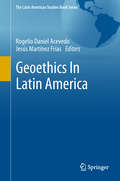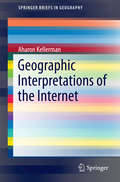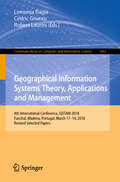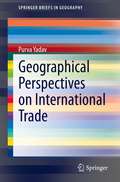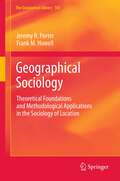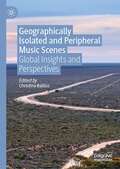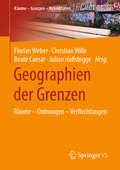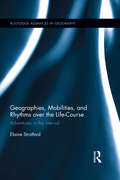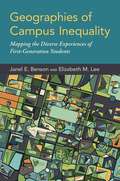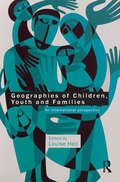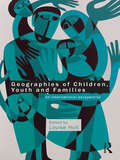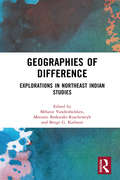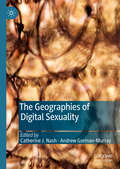- Table View
- List View
Geoethics In Latin America (The Latin American Studies Book Series)
by Rogelio Daniel Acevedo Jesús Martínez FríasThis book studies geoethics in Latin America and offers comprehensive research on geoethics and geoeducation. Its respective chapters explore geoethics in relation to UNESCO geoparks, mining activities in Latin America, natural hazards and risk management. Geoethics is a key discipline in the field of Earth and Planetary Sciences, and not only includes scientific, technological, methodological and social-cultural aspects, but also addresses the need to consider appropriate protocols, scientific integrity issues and a code of good practice when studying the abiotic world.The position of Latin America’s recently created geoethics associations is based on protection of the environment, together with a reassurance that the balance of nature and the rights of human beings to enjoy it will be preserved.
Geographic Interpretations of the Internet (SpringerBriefs in Geography)
by Aharon KellermanThis book introduces the Internet through a systematic geographical interpretation, thus shedding light on the Internet as a spatial entity. The book’s approach is to extend basic concepts developed for terrestrial geography to cyberspace, most notably those relating to space, structure, place, distance, mobility, and presence. It further considers the Internet by its constitution of information space, communications space, and screen space. By using well-known concepts from traditional human geography, this book proposes a combination of terrestrial and virtual geographies, which may in turn help in coping with Internet structures and contents. The book appeals to human and economic geographers, especially those interested in information and Internet geographies. It may also be of special interest and importance to sociologists and media scholars and students dealing with communication technology and the Internet.
The Geographical Dimensions of Terrorism
by Susan L. Cutter Douglas B. Richardson Thomas J. WilbanksFirst published in 2003. Routledge is an imprint of Taylor & Francis, an informa company.
The Geographical Dimensions of Terrorism
by Susan L. Cutter Douglas B. Richardson Thomas J. WilbanksFirst published in 2003. Routledge is an imprint of Taylor & Francis, an informa company.
Geographical Dynamics and Firm Spatial Strategy in China (Springer Geography)
by Shengjun Zhu John Pickles Canfei HeThis book offers the first detailed account of the complex geographical dynamics currently restructuring China’s export-oriented industries. The topics covered are relevant to post-socialist geography, development studies, economics, economic sociology and international studies. It offers academics, international researchers, postgraduate and advanced undergraduate students in these fields an accessible, grounded, yet theoretically sophisticated account of the geographies of global production networks, value chains, and regional development in developing countries and emerging economies. It is of particular interest to economic geographers and economic sociologists involved in the growing debates over local clusters, embeddedness, global sourcing and global production, and over the global value chain/global production network. It also appeals to national policymakers, since it directly addresses economic and industrial policy issues, such as industrial competitiveness, regional and national development, industrial and employment restructuring and trade regulation.
A Geographical Guide to the Real and the Good
by Robert SackFirst published in 2003. Routledge is an imprint of Taylor & Francis, an informa company.
A Geographical Guide to the Real and the Good
by Robert SackFirst published in 2003. Routledge is an imprint of Taylor & Francis, an informa company.
Geographical Indication and Global Agri-Food: Development and Democratization (Earthscan Food and Agriculture)
by Alessandro Bonanno Kae Sekine Hart N. FeuerThis book addresses the relevance of geographical indication (GI) as a tool for local and socio-economic development and democratization of agri-food, with case studies from Asia, Europe and the Americas. A geographical indication is a sign used on products that have a specific geographical origin and possess qualities or a reputation that are due to that origin. It provides not only a way for businesses to leverage the value of their geographically unique products, but also to inform and attract consumers. A highly contested topic, GI is praised as a tool for the revitalization of agricultural communities, while also criticized for being an instrument exploited by global corporate forces to promote their interests. There are concerns that the promotion of GI may hamper the establishment of democratic forms of development. The contributing authors address this topic by offering theoretically informed investigations of GI from around the world. The book includes case studies ranging from green tea in Japan, olive oil in Turkey and dried fish in Norway, to French wine and Mexican Mezcal. It also places GI in the broader context of the evolution and trends of agri-food under neoliberal globalization. The book will be of interest to researchers, policy makers and students in agri-food studies, sociology of food and agriculture, geography, agricultural and rural economics, environmental and intellectual property law, and social development.
Geographical Indication and Global Agri-Food: Development and Democratization (Earthscan Food and Agriculture)
by Alessandro Bonanno Kae Sekine Hart N. FeuerThis book addresses the relevance of geographical indication (GI) as a tool for local and socio-economic development and democratization of agri-food, with case studies from Asia, Europe and the Americas. A geographical indication is a sign used on products that have a specific geographical origin and possess qualities or a reputation that are due to that origin. It provides not only a way for businesses to leverage the value of their geographically unique products, but also to inform and attract consumers. A highly contested topic, GI is praised as a tool for the revitalization of agricultural communities, while also criticized for being an instrument exploited by global corporate forces to promote their interests. There are concerns that the promotion of GI may hamper the establishment of democratic forms of development. The contributing authors address this topic by offering theoretically informed investigations of GI from around the world. The book includes case studies ranging from green tea in Japan, olive oil in Turkey and dried fish in Norway, to French wine and Mexican Mezcal. It also places GI in the broader context of the evolution and trends of agri-food under neoliberal globalization. The book will be of interest to researchers, policy makers and students in agri-food studies, sociology of food and agriculture, geography, agricultural and rural economics, environmental and intellectual property law, and social development.
Geographical Information and Urban Transport Systems
by Arnaud Banos Thomas ThéveninUrban transport systems need to be analyzed from various perspectives: the offer on one hand, the demand on the other hand, but also their negative externalities (risks of transport systems). These three dimensions are rarely apprehended in an integrated perspective. This book provides a large collection of chapters dealing with these specific dimensions, each written by recognized specialists in their domain, and articulates them in an integrated way.
Geographical Information and Urban Transport Systems
by Arnaud Banos Thomas ThéveninUrban transport systems need to be analyzed from various perspectives: the offer on one hand, the demand on the other hand, but also their negative externalities (risks of transport systems). These three dimensions are rarely apprehended in an integrated perspective. This book provides a large collection of chapters dealing with these specific dimensions, each written by recognized specialists in their domain, and articulates them in an integrated way.
Geographical Information Systems Theory, Applications and Management: 4th International Conference, GISTAM 2018, Funchal, Madeira, Portugal, March 17–19, 2018, Revised Selected Papers (Communications in Computer and Information Science #1061)
by Lemonia Ragia Cédric Grueau Robert LauriniThis book constitutes the thoroughly refereed proceedings of the 4th International Conference on Geographical Information Systems Theory, Applications and Management, GISTAM 2018, held in Funchal, Madeira, Portugal, in March 2018.The 7 revised full papers presented were carefully reviewed and selected from 58 submissions. The papers are centered on urban and regional planning; water information systems; geospatial information and technologies; spatio-temporal database management; decision support systems; energy information systems; GPS and location detection.
Geographical Perspectives on International Trade (SpringerBriefs in Geography)
by Purva YadavThis book analyzes spatial and temporal patterns of international trade from a geographical perspective. Trade is an important key to understanding the changing dynamics of economic spaces over time. However, studies by geographers are largely confined to case studies, whereas the spatial dimension is often missing from the approach of economists. This study highlights spatial patterns and commodity composition of global trade and the nature of relationship between trade and other economic attributes. A case study of the MERCOSUR trade block examines inter-regional and intra-regional trade flows. The book captures a comprehensive picture of the structure of international exchange by using ample maps and illustrations as supporting features. Many different methods are applied such as the location quotient to capture concentration and diversification of commodity composition, data reduction techniques such as factor analysis and regression models for relating the economic structures and trade patterns as well as residual mapping among others. This book is a significant contribution to geographical, economical and social sciences research and very useful to graduate and post-graduate students as well as scientists of all related areas who have interest in exploring the changing dynamics of the global economy via trade flows. It provides a road map to further explore different dimensions of international trade and its role in understanding the transforming global economy.
Geographical Sociology: Theoretical Foundations and Methodological Applications in the Sociology of Location (GeoJournal Library #105)
by Jeremy R. Porter Frank M. HowellThe discipline of Sociology has a rich history of including spatial context in the analysis of social issues. Much of this history has revolved around the development and application of spatial theory aimed at understanding the geographic distribution of social problems, the organization of communities, and the relationship between society and the environment. More recently, the social sciences have seen a large number of technological innovations that now make it possible to place social behaviour in spatial context. Consequently, because of the historical disjuncture in the development of spatial theory and the recent development of relevant methodological tools, the relationship between materials describing both the methodological approaches and their theoretical importance a scattered throughout various books and articles. Geographical Sociology consolidates these materials into a single accessible source in which spatial concepts such as containment, proximity, adjacency, and others are examined in relation to such methodological tools as hierarchical linear models, point pattern analysis, and spatial regression. As these methods continue to increase in popularity among social scientists the ability to more generally understand societies relationship to geographic space will continue to increase in it importance in the field. This book represents a starting point to linking these concepts to practice and is presented in an accessible form in which students, researchers, and educators can all learn, and in turn, contribute to its development.
Geographically Isolated and Peripheral Music Scenes: Global Insights and Perspectives
by Christina BallicoThis book explores the influence of geographical isolation and peripherality on the functioning of music industries and scenes which operate within and from such locales. As is explored, these sites engage dynamic practices to offset challenges resulting from geographical isolation and peripherality.
Geographien der Grenzen: Räume – Ordnungen – Verflechtungen (Räume – Grenzen – Hybriditäten)
by Florian Weber Christian Wille Beate Caesar Julian HollsteggeDer Sammelband diskutiert den Zusammenhang von Räumen, Ordnungen und Verflechtungen. Die Autor*innen aus den Raum-, Sozial- und Kulturwissenschaften wählen unterschiedliche Zugänge zu Grenzen und analysieren ihre (Re-)Produktionsprozesse als ‚Geographien der Grenzen‘. Dabei rücken sie auch andere als nationalstaatliche Grenzen in den Blick, wie zum Beispiel stadtlandhybride Differenzierungen. So wird in diesem Band aus verschiedenen theoretischen und thematischen Blickwinkeln der Frage nachgegangen, wie und welche ,Geographien der Grenzen‘ sich im Zusammenspiel von unterschiedlichen Destabilisierungen und (Re-)Stabilisierungen von Grenzen (re)konstruieren lassen.
Geographies, Mobilities, and Rhythms over the Life-Course: Adventures in the Interval (Routledge Advances in Geography)
by Elaine StratfordBy thinking in terms of the geographies of mobilities, we are better able to understand the central importance of movements, rhythms and shifting emplacements over the life-course. This innovative book represents research from a new and flourishing multidisciplinary field that includes, among other things, studies on smart cities, infrastructures and networks; mobile technologies for automated highways or locative media; mobility justice and rights to stay or enter or reside. These activities, cadences and changing attachments to place have profound effects—first upon how we conduct or govern ourselves and each other via many social institutions, and second upon how we constitute the spaces in and through which our lives are experienced. This scholarship also has clear connections to numerous aspects of social and spatial policy and planning.
Geographies, Mobilities, and Rhythms over the Life-Course: Adventures in the Interval (Routledge Advances in Geography)
by Elaine StratfordBy thinking in terms of the geographies of mobilities, we are better able to understand the central importance of movements, rhythms and shifting emplacements over the life-course. This innovative book represents research from a new and flourishing multidisciplinary field that includes, among other things, studies on smart cities, infrastructures and networks; mobile technologies for automated highways or locative media; mobility justice and rights to stay or enter or reside. These activities, cadences and changing attachments to place have profound effects—first upon how we conduct or govern ourselves and each other via many social institutions, and second upon how we constitute the spaces in and through which our lives are experienced. This scholarship also has clear connections to numerous aspects of social and spatial policy and planning.
Geographies of Campus Inequality: Mapping the Diverse Experiences of First-Generation Students
by Janel E. Benson Elizabeth M. LeeIn efforts to improve equity, selective college campuses are increasingly focused on recruiting and retaining first-generation students-those whose parents have not graduated from college. In Geographies of Campus Inequality, sociologists Benson and Lee argue that these approaches may fall short if they fail to consider the complex ways first-generation status intersects with race, ethnicity, and gender. Drawing on interview and survey data from selective campuses, the authors show that first-generation students do not share a universal experience. Rather, first-generation students occupy one of four disparate geographies on campus within which they negotiate academic responsibilities, build relationships, engage in campus life, and develop post-college aspirations. Importantly, the authors demonstrate how geographies are shaped by organizational practices and campus constructions of class, race, and gender. Geographies of Campus Inequality expands the understanding of first-generation students' campus lives and opportunities for mobility by showing there is more than one way to be first-generation.
Geographies of Campus Inequality: Mapping the Diverse Experiences of First-Generation Students
by Elizabeth M. Lee Janel E. BensonIn efforts to improve equity, selective college campuses are increasingly focused on recruiting and retaining first-generation students-those whose parents have not graduated from college. In Geographies of Campus Inequality, sociologists Benson and Lee argue that these approaches may fall short if they fail to consider the complex ways first-generation status intersects with race, ethnicity, and gender. Drawing on interview and survey data from selective campuses, the authors show that first-generation students do not share a universal experience. Rather, first-generation students occupy one of four disparate geographies on campus within which they negotiate academic responsibilities, build relationships, engage in campus life, and develop post-college aspirations. Importantly, the authors demonstrate how geographies are shaped by organizational practices and campus constructions of class, race, and gender. Geographies of Campus Inequality expands the understanding of first-generation students' campus lives and opportunities for mobility by showing there is more than one way to be first-generation.
Geographies of Children, Youth and Families: An International Perspective
by Louise HoltThis edited collection brings together international experts from the vibrant and growing field of geographies of children, youth and families. Designed as an introduction to the topic, this book provides an overview of current conceptual and theoretical debates surrounding geographies of children, youth and families, and gives a wide range of examples of cutting-edge research from a variety of national contexts across the globe. The theme of ‘disentangling the socio-spatial contexts of young people and/or their families’ advances debates in the field by emphasising the context of young people’s social agency. Geographies of Children, Youth and Families is an invaluable course text for undergraduate and postgraduate students of geography and the social sciences, as well as being of interest to students and practitioners of education, youth work, social policy, and social work.
Geographies of Children, Youth and Families: An International Perspective
by Louise HoltThis edited collection brings together international experts from the vibrant and growing field of geographies of children, youth and families. Designed as an introduction to the topic, this book provides an overview of current conceptual and theoretical debates surrounding geographies of children, youth and families, and gives a wide range of examples of cutting-edge research from a variety of national contexts across the globe. The theme of ‘disentangling the socio-spatial contexts of young people and/or their families’ advances debates in the field by emphasising the context of young people’s social agency. Geographies of Children, Youth and Families is an invaluable course text for undergraduate and postgraduate students of geography and the social sciences, as well as being of interest to students and practitioners of education, youth work, social policy, and social work.
Geographies of Difference: Explorations in Northeast Indian Studies
by Mélanie Vandenhelsken Meenaxi Barkataki-Ruscheweyh Bengt G. KarlssonThis book rethinks Northeast India as a lived space, a centre of interconnections and unfolding histories, instead of an isolated periphery. Questioning dominant tropes and assumptions around the Northeast, it examines socio-political and historical processes, border issues, the role of the state, displacement and development, debates over natural resources, violence, notions of body and belonging, movements, tensions and relations, and strategies, struggles and narratives that frame discussions on the region. Drawing on current and emerging research in Northeast India studies, this work will be of great interest to scholars and researchers of politics, human geography, sociology and social anthropology, history, cultural studies, media studies and South Asian studies.
Geographies of Difference: Explorations in Northeast Indian Studies
by Mélanie Vandenhelsken Meenaxi Barkataki-Ruscheweyh Bengt G. KarlssonThis book rethinks Northeast India as a lived space, a centre of interconnections and unfolding histories, instead of an isolated periphery. Questioning dominant tropes and assumptions around the Northeast, it examines socio-political and historical processes, border issues, the role of the state, displacement and development, debates over natural resources, violence, notions of body and belonging, movements, tensions and relations, and strategies, struggles and narratives that frame discussions on the region. Drawing on current and emerging research in Northeast India studies, this work will be of great interest to scholars and researchers of politics, human geography, sociology and social anthropology, history, cultural studies, media studies and South Asian studies.
The Geographies of Digital Sexuality
by Catherine J. Nash Andrew Gorman-MurrayThis edited book engages with the rapidly emerging field of the geographies of digital sexualities, that is, the interlinkages between sexual lives, material and virtual geographies and digital practices. Modern life is increasingly characterised by our integrated engagement in digital/material landscapes activities and our intimate life online can no longer be conceptualised as discrete from ‘real life.’ Our digital lives are experienced as a material embeddedness in the spaces of everyday life marking the complex integration of real and digital geographies. Perhaps nowhere is this clearer than in the ways that our social and sexual practices such as dating or casual sex are bound up online and online geographies and in many cases constitute specific sexuality-based communities crossing the digital/material divide. The aim of this collection is to explore the complexities of these newly constituted and interwoven sexual and gender landscapes through empirical, theoretical and conceptual engagements through wide-ranging, innovative and original research in a new and quickly moving field.
